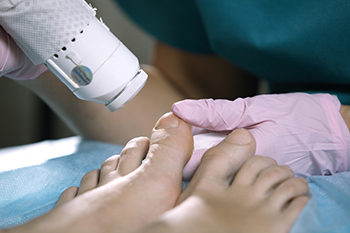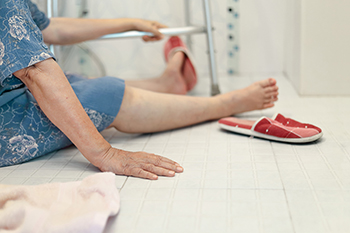Items filtered by date: December 2021
Tips for Preventing Blisters
Foot blisters are a common but very annoying problem. Fortunately, there are many ways to prevent them. First, you should look for a shoe that fits well, holds your heel firmly in place, and leaves some wiggle room for your toes. Avoid buying shoes with rough seams or edges along the inside, as these can irritate the skin. Socks are important too. Look for socks that are made with a moisture-wicking material. These will help keep your feet dry. You can also use an antiperspirant or talcum powder. Toughen the skin on your feet by slowly increasing the distance of your walks or runs and by moisturizing your heels if they are dry. If you have certain areas of your feet that are prone to blistering, cover them with sports tape, moleskin, or special patches to protect them. For more information about how to prevent foot blisters, please consult with a podiatrist.
Blisters may appear as a single bubble or in a cluster. They can cause a lot of pain and may be filled with pus, blood, or watery serum. If your feet are hurting, contact Alex Yanovskiy, DPM of Illinois Foot & Ankle Clinic. Our doctor can provide the care you need to keep you pain-free and on your feet.
Foot Blisters
Foot blisters are often the result of friction. This happens due to the constant rubbing from shoes, which can lead to pain.
What Are Foot Blisters?
A foot blister is a small fluid-filled pocket that forms on the upper-most layer of the skin. Blisters are filled with clear fluid and can lead to blood drainage or pus if the area becomes infected.
Symptoms
(Blister symptoms may vary depending on what is causing them)
- Bubble of skin filled with fluid
- Redness
- Moderate to severe pain
- Itching
Prevention & Treatment
In order to prevent blisters, you should be sure to wear comfortable shoes with socks that cushion your feet and absorb sweat. Breaking a blister open may increase your chances of developing an infection. However, if your blister breaks, you should wash the area with soap and water immediately and then apply a bandage to the affected area. If your blisters cause severe pain it is important that you call your podiatrist right away.
If you have any questions, please feel free to contact our office located in Des Plaines , IL . We offer the newest diagnostic and treatment technologies for all your foot care needs.
How MLS Laser Therapy Sheds Light on Pain and Inflammation
MLS (Multiwave Locked System) Laser Therapy is a non-invasive method of treatment that uses two continuous therapeutic wavelengths of light that penetrate deep into the tissue to stimulate the regeneration of cells, decrease pain and inflammation, and improve circulation to the injured area. While there may be a slight warming sensation at the site of treatment, the combination of these two synchronized wavelengths minimizes the risk of thermal damage. Treatments generally take 10-15 minutes, and the typical course of treatment entails roughly 6 to 12 treatments. Many patients experience long-term positive results from MLS Therapy, as it addresses the cause of pain rather than simply masking symptoms. Podiatrists may use MLS therapy to treat plantar fasciitis, Achilles tendon issues, bursitis, neuromas, arthritis, fractures, injuries, and more. If you have any of these conditions, talk to your podiatrist to see if you are a good candidate for MLS Laser Therapy.
MLS Laser Therapy is a successful alternative for treating any pain you may be experiencing related to certain podiatric conditions. If you are interested in MLS Laser Therapy, consult with Alex Yanovskiy, DPM from Illinois Foot & Ankle Clinic. Our doctor will assess your condition and provide you with quality foot and ankle treatment.
MLS Laser Therapy
Multiwave Locked System (MLS) Laser Therapy is a patented, FDA-cleared technology that helps relieve pain and inflammation from a number of podiatric conditions, including:
- Heel Pain
- Plantar Fasciitis
- Sports Injuries
- Wounds
- Achilles Tendonitis
- Arthritis
- Neuropathy
- Neuromas
MLS Laser Therapy is an ideal alternative to surgery and prescription medication, as it has no negative side effects and encourages accelerated healing. Among its many clinical benefits, MLS Laser Therapy also:
- Reduces swelling due to bruising or inflammation
- Blocks pain
- Reduces formation of scar tissue
- Improves nerve function
If you have any questions, please feel free to contact our office located in Des Plaines , IL . We offer the newest diagnostic and treatment technologies for all your foot care needs.
Types of Corns and Calluses
 Corns and calluses are thickened areas of skin that form as a means of protection on the feet. These thick areas primarily form where the skin has rubbed against something like a shoe. Thickened areas of skin that are larger and irregularly shaped are known as calluses. They usually indicate issues such as bone deformity, improper footwear, or a poor walking style. Hardened areas of skin that are smaller with a central core are known as corns. A variety of corns can form, including soft corns, which usually develop in areas that are moist from sweat or inadequate drying between the toes. Corns that contain nerve fibers and blood vessels are known as vascular corns, which can be very painful. Other types of corns include hard corns, fibrous corns, and seed corns. Patients with corns or calluses that persistently irritate their foot should consult with a podiatrist for treatment.
Corns and calluses are thickened areas of skin that form as a means of protection on the feet. These thick areas primarily form where the skin has rubbed against something like a shoe. Thickened areas of skin that are larger and irregularly shaped are known as calluses. They usually indicate issues such as bone deformity, improper footwear, or a poor walking style. Hardened areas of skin that are smaller with a central core are known as corns. A variety of corns can form, including soft corns, which usually develop in areas that are moist from sweat or inadequate drying between the toes. Corns that contain nerve fibers and blood vessels are known as vascular corns, which can be very painful. Other types of corns include hard corns, fibrous corns, and seed corns. Patients with corns or calluses that persistently irritate their foot should consult with a podiatrist for treatment.
Corns can make walking very painful and should be treated immediately. If you have questions regarding your feet and ankles, contact Alex Yanovskiy, DPM of Illinois Foot & Ankle Clinic. Our doctor will treat your foot and ankle needs.
Corns: What Are They? And How Do You Get Rid of Them?
Corns are thickened areas on the skin that can become painful. They are caused by excessive pressure and friction on the skin. Corns press into the deeper layers of the skin and are usually round in shape.
Ways to Prevent Corns
There are many ways to get rid of painful corns such as:
- Wearing properly fitting shoes that have been measured by a professional
- Wearing shoes that are not sharply pointed or have high heels
- Wearing only shoes that offer support
Treating Corns
Although most corns slowly disappear when the friction or pressure stops, this isn’t always the case. Consult with your podiatrist to determine the best treatment option for your case of corns.
If you have any questions please feel free to contact our office located in Des Plaines , IL . We offer the newest diagnostic and treatment technologies for all your foot and ankle needs.
Are Bunions Affecting Your Everyday Life?
Tips for Older Adults to Avoid Falls Around the Home
With falls being among the top safety hazards for senior citizens, it’s important to reduce the risks of falling at home. Simple behavioral precautions are a good start, such as walking carefully and not rushing around to perform other tasks. Halls, stairs, and high traffic areas should be clutter-free, and any objects on the ground that could be a tripping hazard should be removed. Never rush up or down on the stairs, always use the handrail, and remove any objects that could be tripped over. Remove or tape down mats and rugs so they are secure as you walk or stand on them. Grab bars in the shower/tub and next to the commode can help keep you safer in the bathroom. It’s also a good practice to avoid going barefoot. Slippers should be close-backed and well-fitted (not loose) with slip-resistant soles. Footwear should have a proper fit and structure to provide balance and support at all times. A podiatrist should be consulted as well for professional advice on footwear and to address any issues with your feet or gait which may be compromising your mobility and balance.
Preventing falls among the elderly is very important. If you are older and have fallen or fear that you are prone to falling, consult with Alex Yanovskiy, DPM from Illinois Foot & Ankle Clinic. Our doctor will assess your condition and provide you with quality advice and care.
Every 11 seconds, an elderly American is being treated in an emergency room for a fall related injury. Falls are the leading cause of head and hip injuries for those 65 and older. Due to decreases in strength, balance, senses, and lack of awareness, elderly persons are very susceptible to falling. Thankfully, there are a number of things older persons can do to prevent falls.
How to Prevent Falls
Some effective methods that older persons can do to prevent falls include:
- Enrolling in strength and balance exercise program to increase balance and strength
- Periodically having your sight and hearing checked
- Discuss any medications you have with a doctor to see if it increases the risk of falling
- Clearing the house of falling hazards and installing devices like grab bars and railings
- Utilizing a walker or cane
- Wearing shoes that provide good support and cushioning
- Talking to family members about falling and increasing awareness
Falling can be a traumatic and embarrassing experience for elderly persons; this can make them less willing to leave the house, and less willing to talk to someone about their fears of falling. Doing such things, however, will increase the likelihood of tripping or losing one’s balance. Knowing the causes of falling and how to prevent them is the best way to mitigate the risk of serious injury.
If you have any questions, please feel free to contact our office located in Des Plaines , IL . We offer the newest diagnostic and treatment technologies for all your foot care needs.




